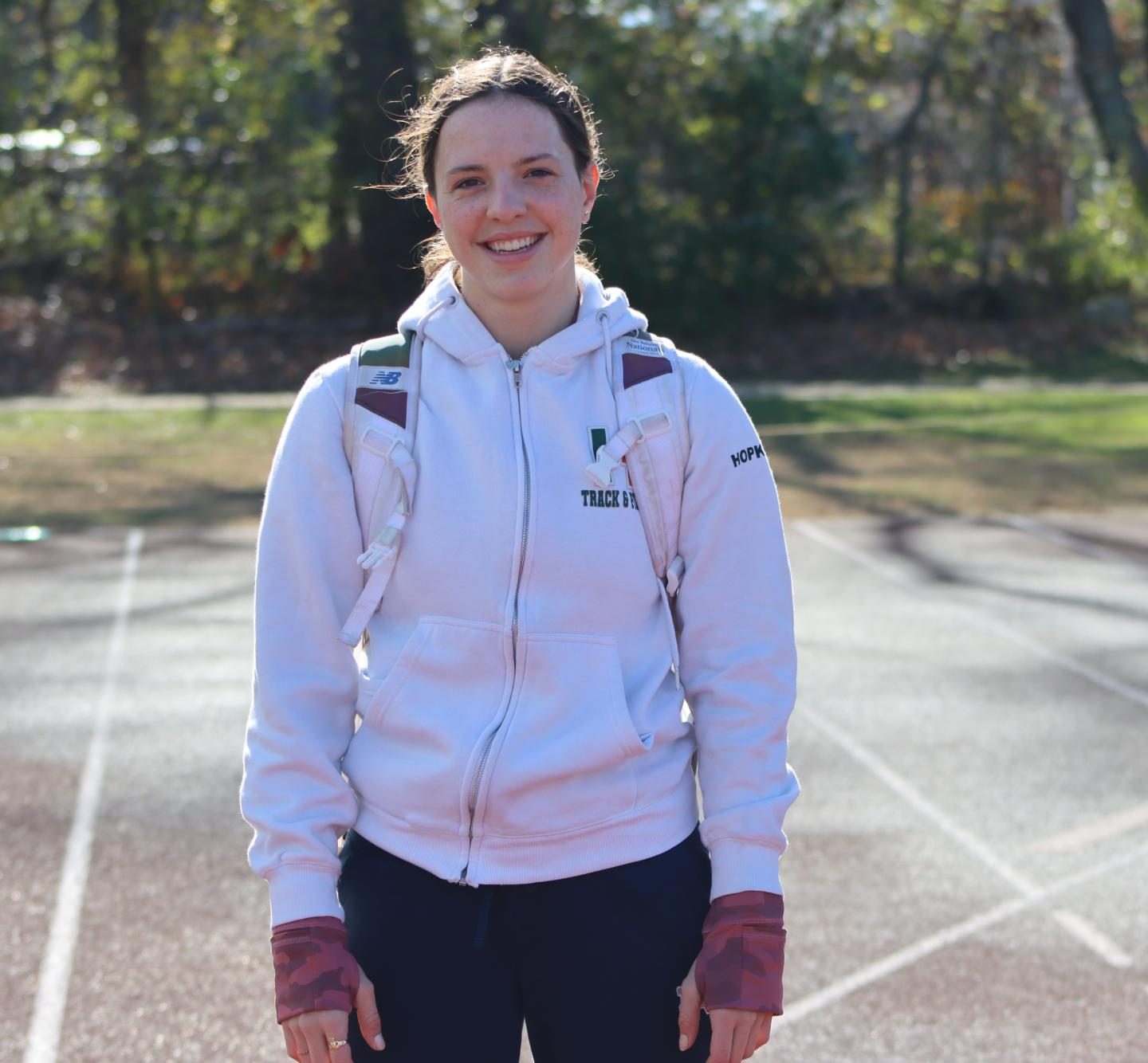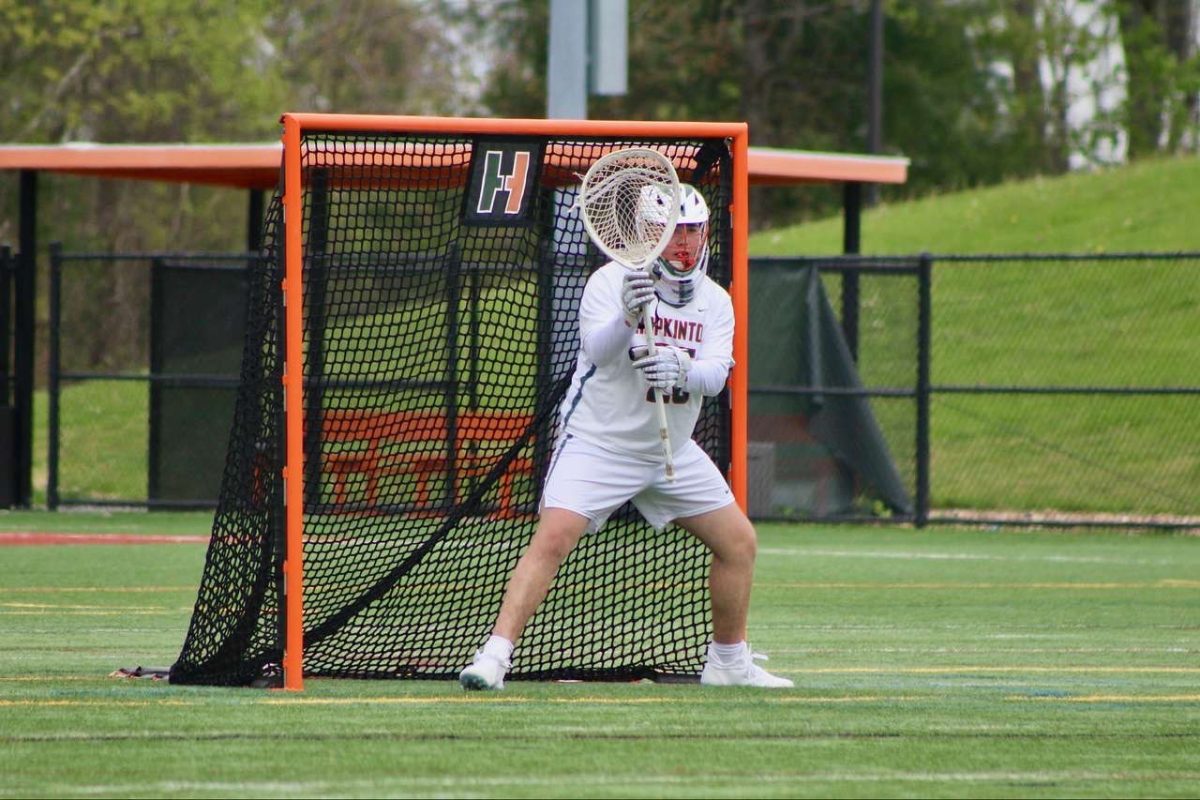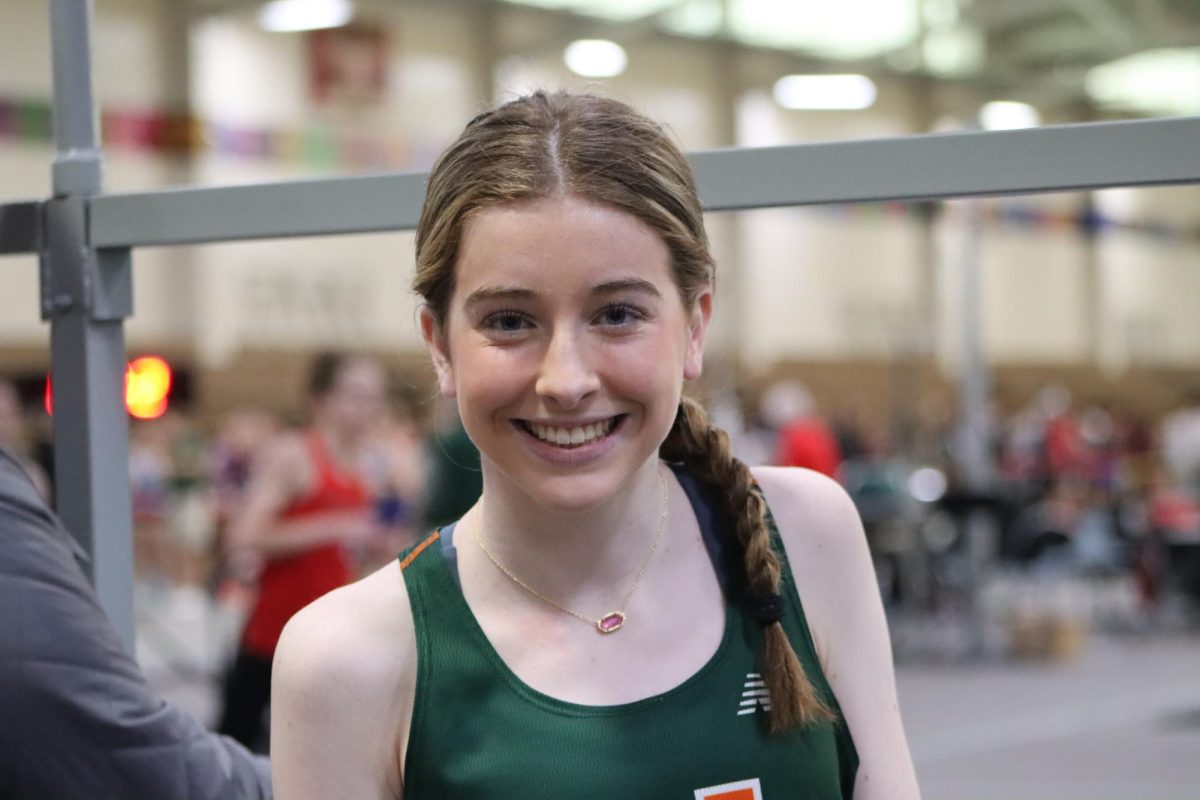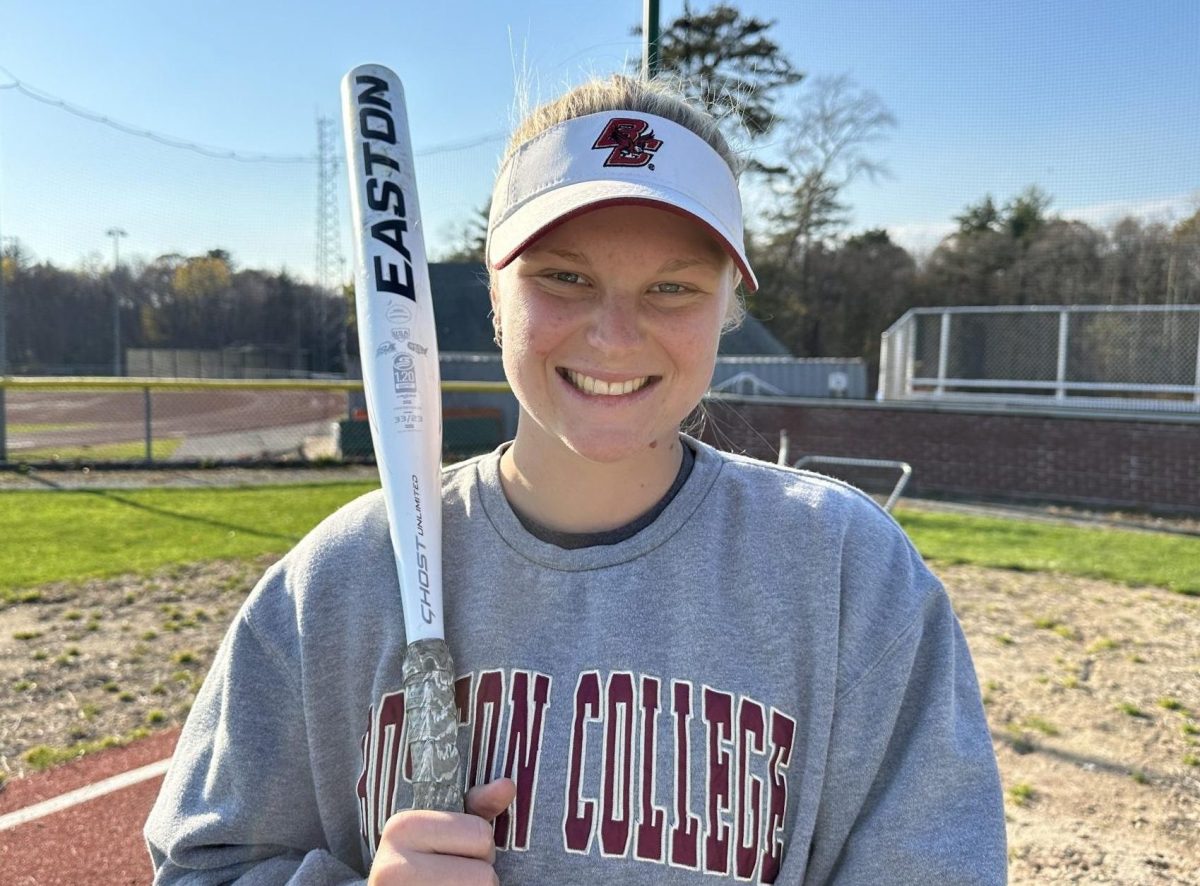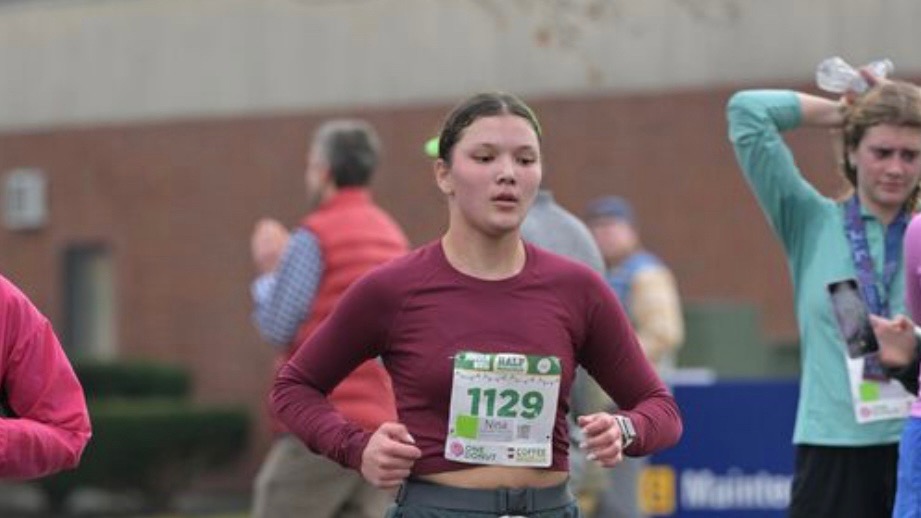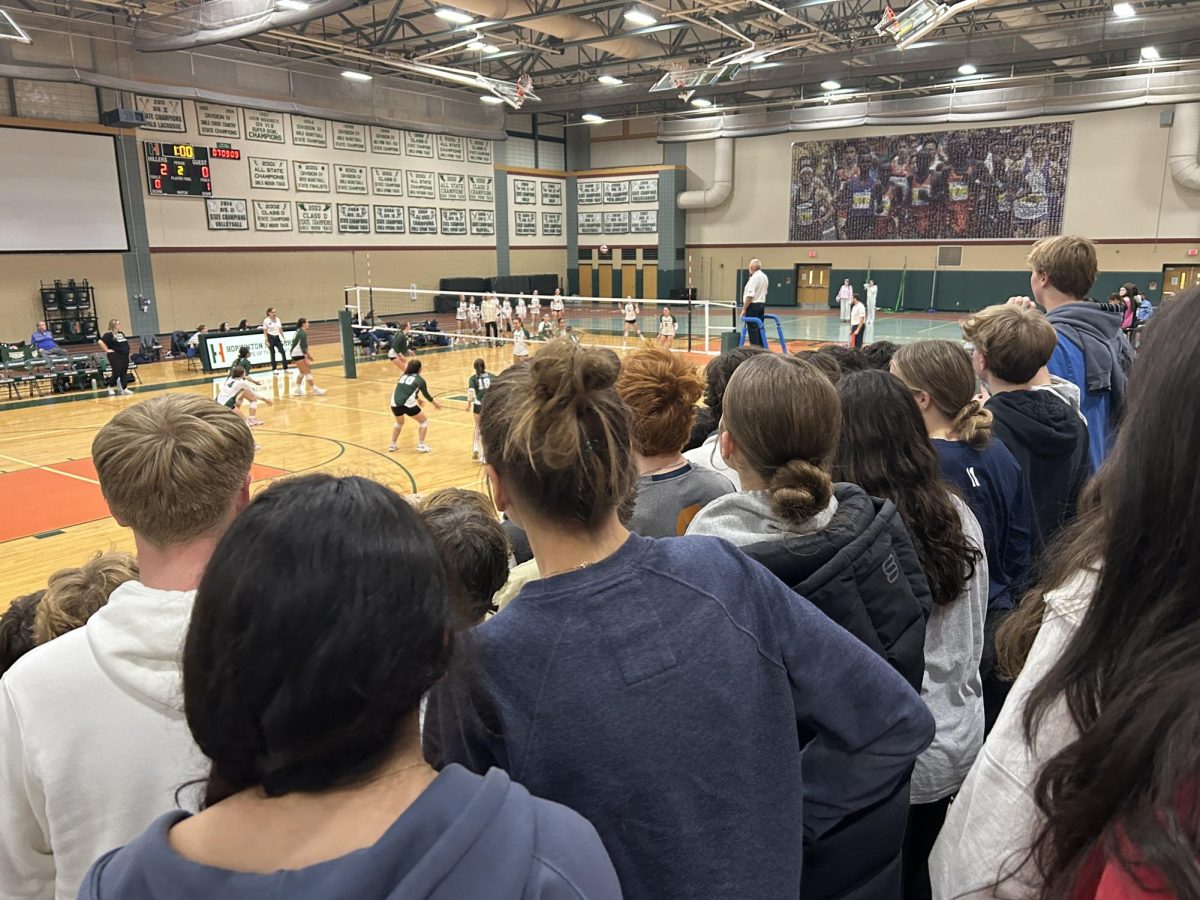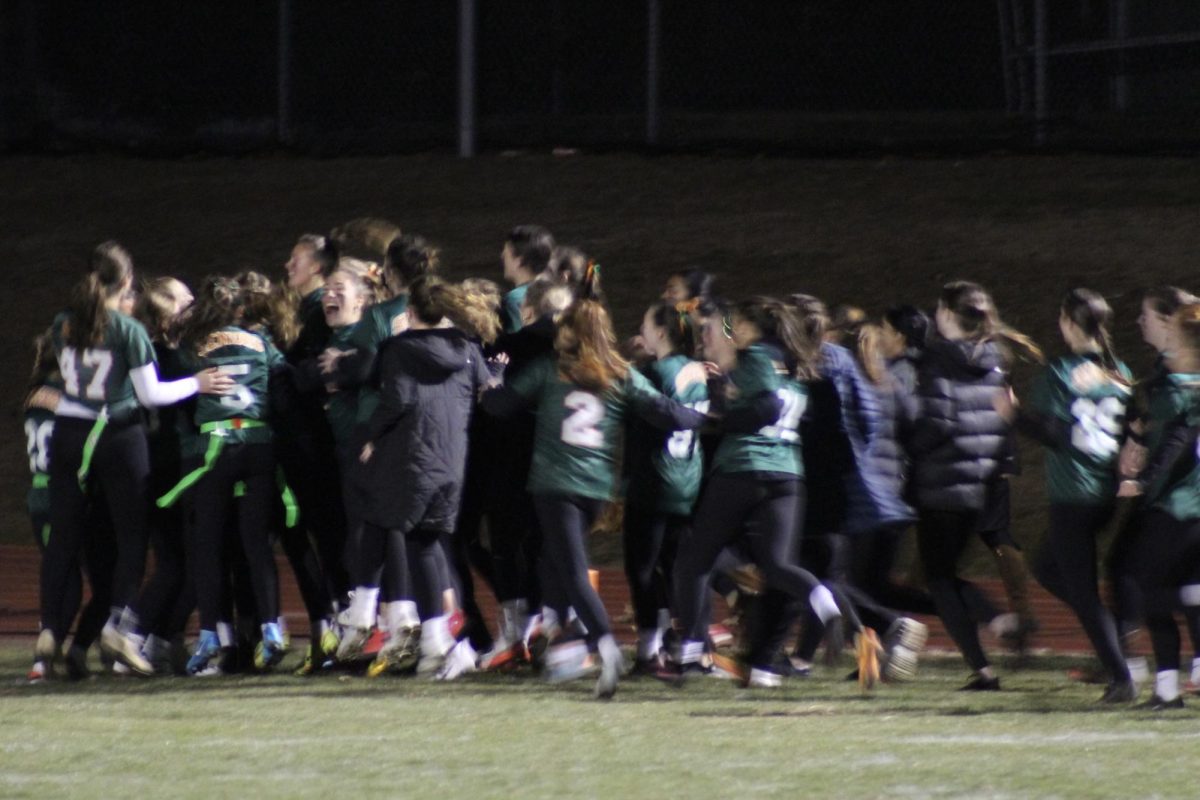The wind blows cold on a cloudy March afternoon in Medfield, Massachusetts. The trees rustle their young leaves, welcoming springtime and a busload of Hopkinton athletes. The team—boasting Hiller gear—pours from the doors of three buses and funnels through a small, chain-link gate onto the opposing town’s crimson track.
It’s a sea of green and orange. Somehow, the swarm of over two hundred high schoolers arranges into a relatively organized mass as the coaches emerge with two massive tents, placing them, folded, just beyond the 400-meter scarlett ring.
The tents are heavy. More often than not, the task of setting them up falls on the male throwers. As the Hopkinton athletes toss their bags onto the grass, the legs of the tents are grabbed by three boys: a stocky discus thrower and two muscled shot putters.
But easily hoisting the fourth leg is Josie Hopkins.
Once the tent is secured, Hopkins tosses her bag—a white and metallic purple backpack brandished with her name and New Balance Nationals 2023—on the grass with the rest of her teammates’ gear. It clatters with the sound of her track essentials: BIOFREEZE, snacks, electrolyte tablets, spikes, a spike wrench, and a hand towel for dusting off sand after long jump. The bag, embroidered with a purple patch reading “JUMP,” is an emblem of her success, and it’s got everything she needs.
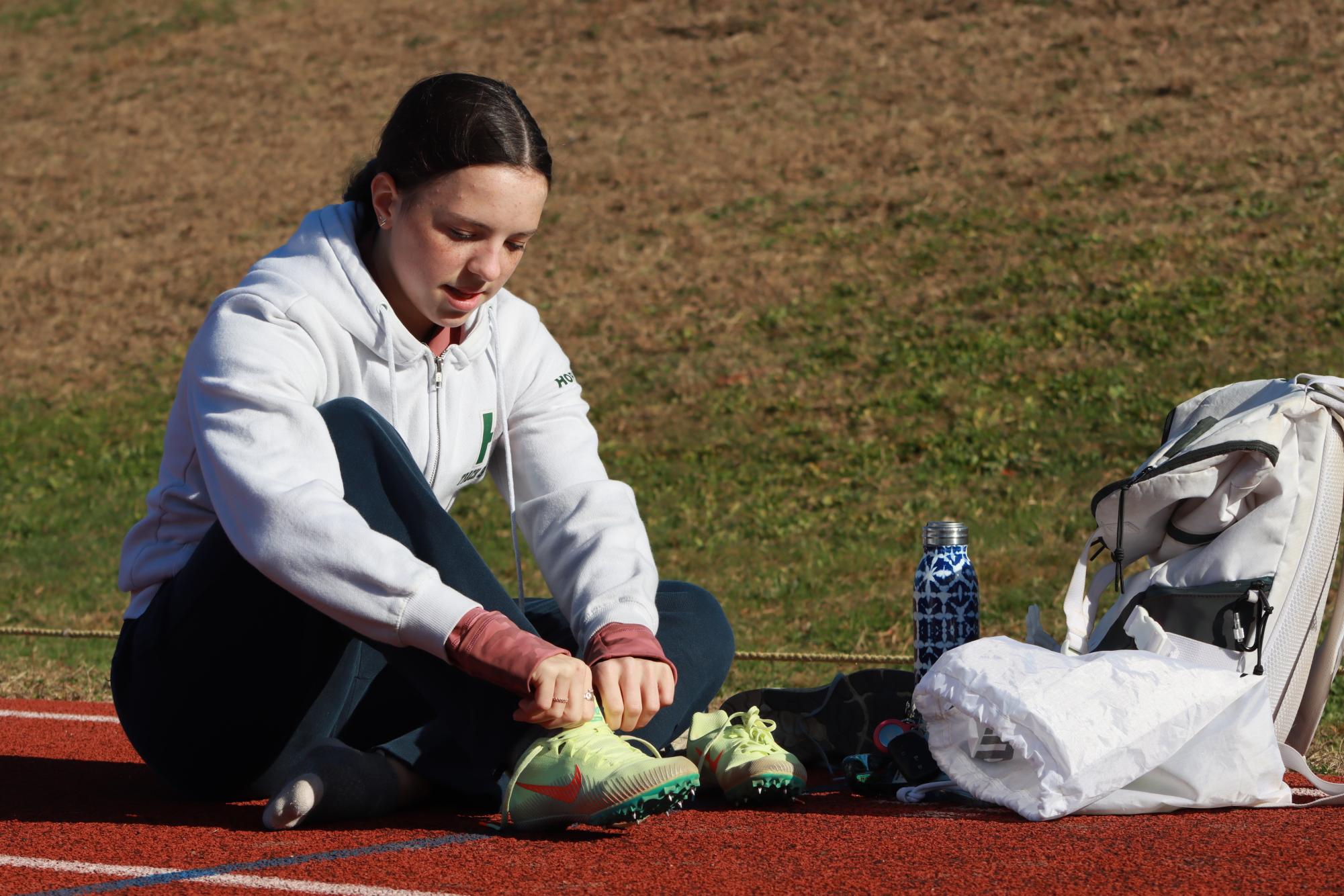
Since her freshman year, Hopkins has set herself apart not only by her natural talent for track and field but by her determination, which fuels her to be one of the strongest competitors. Her unwavering motivation led her to qualify for nationals, place tenth in the state in the pentathlon, and be selected as a junior captain, as well as inspire many of her coaches and teammates.
Around the oval, people are starting to disperse. The track is littered with runners jogging and stretching.
Hopkins eyes the high jump mat, the long jump pit, and the straightaway, her three focal points for the day. She’s wearing her typical white Hillers crewneck and wide-leg black sweatpants. Her hair is pulled back into a tight ponytail; two small braids crown her head before they disappear into the elastic. When twisted this way, the braids keep her hair out of her face. She’s high jumping today, so no ribbons cascade through her ponytail. She never wears ribbons when she high jumps.
She watches her teammates begin to stretch. Although outdoor meets are less crowded, the oval is far from empty. Coaches make their rounds, reminding athletes to warm up and start checking in. Hopkins lets out a deep exhale.
“Nervous?”
She turns, surprised. It’s Coach Prescott. He’s wearing his green-and-white striped Hopkinton polo, clipboard resting at his hip in his quintessential coach-like manner.
Hopkins shakes her head. “Nope.”
She feels jittery, but it isn’t nerves. Coach MacKenzie told her to trick herself into thinking the nervousness was excitement. So she likes to say she’s excited before she jumps or races. Today, it will be both.
“Good,” Prescott says, nodding, staring toward the high jump mat as she had. “Nice day for it.”
As he leaves, Hopkins shivers after a chilly gust of wind, and she notes her coach’s optimism despite the brisk conditions. It feels sub-zero. At least she isn’t running the mile.
The longest she has run competitively is 800 meters—a half mile and certainly not her favorite event. She’s had run-ins with shin splints before, and the 800 is where they flare up the most. Hopkins isn’t a fan of long-distance, despite having done cross country in the past. She joined as a freshman but opted out the next fall to focus more time on track-specific training. Track and field is where she excels.
Since her freshman year, she has known what event she wants to specialize in—all of them. Hopkins does multi-events or multis. From the pentathlon in the winter to the heptathlon in the spring, her repertoire spans over fourteen events: High jump, long jump, triple jump, 55m hurdles, 100m hurdles, 400m hurdles, 55m, 100m, 200m, 300m, 400m, 800m, shot put, and javelin.
Although she loves the pentathlon because it’s a mix of events, Hopkins’ heart will always belong to long jump. It’s the least stressful for her. She says it is “fun to play in the sand.” Prescott, the sprinting and jumping coach Hopkins spends the most time with, agrees. He believes she is a true jumper.
He’s thought highly of Hopkins since she first stepped onto the track. “She has been an integral part of the indoor and outdoor track teams since she was a freshman,” Prescott said, attributing this to her coachability, humility, and passion.
Coach Cann, the girls’ head coach who specializes in long-distance, echoes Prescott’s compliments of Hopkins’ work ethic, especially as a multi-event athlete. “There aren’t really any shortcuts when you’re doing that many events and trying to do them all well,” Cann said. “You have to commit to learning all the different events and improving the technique.” Cann believes Hopkins’ love for the sport fuels her desire to improve. “She doesn’t just do things to do things. She finds things she’s passionate about and goes all-in.”
But despite the time she spends honing her craft, Hopkins never fails to prioritize her teammates. “She has never once put herself before the rest of the team and that has allowed her to stay open-minded to new ideas and coaching points,” Prescott said. He admires how quickly Hopkins absorbs information and can apply it immediately in competition.
Prescott’s coaching means a lot to Hopkins. He always lets her add on to her workout if she desires. He always has something extra after a lift she can do, and he admires her passion for self-improvement.
“She never accepts mediocrity,” Prescott said. In terms of work ethic, he can think of no one more committed to her craft than Hopkins. She is always the last out of practice, always willing to push herself and others.
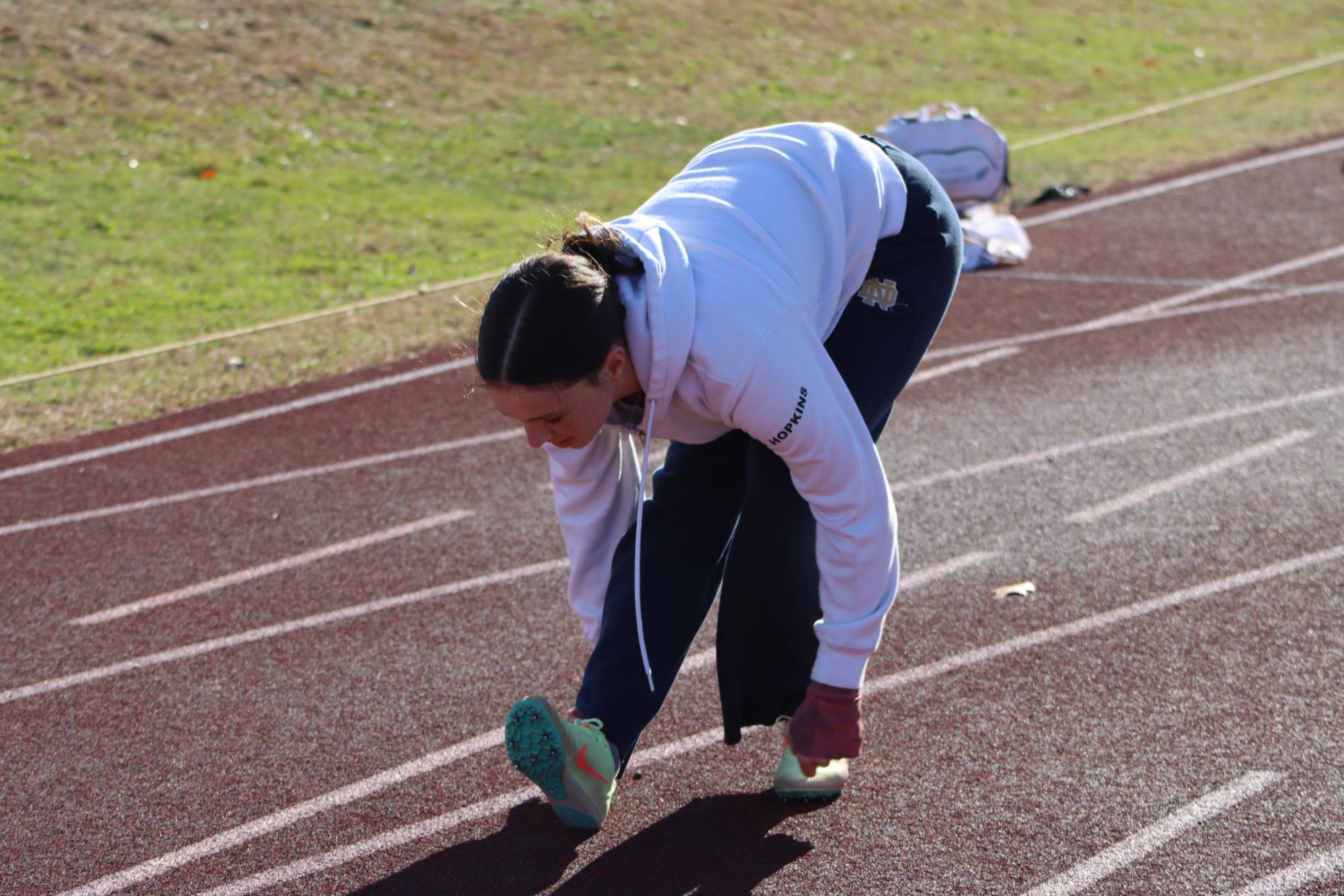
Hopkins’ passion is infectious, and track and field alum Bridget O’Connor witnessed her motivation while lifting with Hopkins two years ago.
O’Connor, also a multi-event athlete, specialized in high jump and hurdles as well as triple jump. Both Hopkins and Prescott believe triple jump to be the most difficult event in track and field, in addition to being the best example of pure athleticism in the sport. To perform well in the event, jumpers must have speed on the approach, explosiveness on the take-off, coordination to maneuver the footwork, raw strength to absorb many times their body weight and continue bounding, and stamina to repeat the jump multiple times in one session. Of course, this requires strength training, so the girls often hit the weight room regularly after practice.
As the scent of rubber dumbbells mingled with the percussive sound of Reputation by Taylor Swift, they laid out their program. Their muscles were already tired from working out but continued nevertheless.
“Let’s do squats,” Hopkins suggested, pulling her ankle behind her, and stretching out her quad.
O’Connor looked surprised. “But we just did lactic acids.”
Hopkins shrugged. Much of her training is additional and unsupervised. During her year off from cross country, she frequently drove to the track to do workouts on her own. She asked Prescott for advice on what jumps to practice and what distances to train. Even though she had no official, coached training, she would hit the weights and prepare for her season. Now that the season had arrived, her supplemental training did not stop.
Approaching the bar, Hopkins slid the iron discs onto each end, brushing her hands together once the weight was set.
“120,” she said. “We’ll start light.”
She shuffled into position, placing her hands beneath the metal bar and hoisting it off the rack. Then, sinking into a deep squat, she reached near-perfect form and rose back to a standing position. Of course, this weight was easy. She could do more than one rep. But they were looking to max out. So they added more discs.
“130,” Hopkins stated, completing another squat.
O’Connor did the same.
More discs.
“140.”
Hopkins’ legs were beginning to burn. O’Connor’s knees were starting to shake.
After 150 pounds, O’Connor shook her head. “I’ve gotta be done for today. I don’t think I can go much higher.”
Hopkins approached the rack of discs, grabbing one in each hand. “Five more pounds. You can do it. After this, we rest.”
Reluctantly, O’Connor stepped back under the bar. Quads complaining, she lowered herself into a squat, then rose to stand, almost thrusting the bar back onto its rack and letting out a massive exhale.
Hopkins beamed. “See?”
Through an exhausted grin, O’Connor laughed.
They were there again the next day.
Despite the protesting muscles in their legs, they added weight, bit by bit. In two weeks, they had made it to 180. In three, 200. Four weeks later, O’Connor sunk, bar resting on her shoulders and, eyes squeezed shut, fighting through pain as she squatted the heaviest weight of her life. As the bar clattered against the rack, Hopkins jumped in the air.
“235!” she shouted ecstatically, wrapping her arms around O’Connor. “That’s 80 from where you started!”
O’Connor smiled as Hopkins patted her on the back. The older girl admired her friend’s motivation. Being teammates with Hopkins was something special. She regarded Hopkins as “one of the most dedicated people [she’d] ever met.”
“She pushes others to be the best they can be,” O’Connor said. “But one of her best qualities is her perseverance.”
O’Connor, a then-senior captain and somewhat of a mentor to this younger athlete, was exceptionally proud of the progress Hopkins had made as a multi-eventer. O’Connor was there when Hopkins was learning how to jump and hurdle in the beginning, and now Hopkins is the expert on it.

Hopkins’ expertise brought her to Indoor Nationals in her sophomore year. She qualified during her third indoor meet, clearing 5’0” in high jump. She trained consistently over the summer with O’Connor and other jumpers, which led to a personal record (PR) of 4’10” in a summer meet. This filled her with confidence. Coming into the indoor season, she was ready to jump even higher.
Breathing in the stale air of Reggie Lewis Center in Boston, Hopkins prepared for her jump. Indoors, in this blue-tracked athletic arena, was where she traditionally achieved personal records. She was excited to be back. She had been waiting for this. She warmed up 45 minutes before her event, giving her time for practice runs.
Then, her name was called.
She stood at her high jump mark, set back at an angle on the left side of the mat. She exhaled, rising onto her toes, then leaning back three times.
“Ok, Josie. Just go for it,” she thought.
Fueled by confidence and adrenaline, Hopkins launched from her right foot, taking four graceful bounds, then four quick steps to explode off her neon yellow spikes into the air, arching her back, and, finally, collapsing on the mat, the bar resting still above her.
She had cleared it.
She found out after she successfully jumped it, 5’0” was the national standard.
High jump is Hopkins’ favorite. She’s spent a lot of time on the event, and it brought her to nationals.
She started jumping when she joined the middle school track team in eighth grade. She used to do gymnastics, dance, and acrobatics. So she liked flipping around on the mat. But her strongest performance came from a combination of five events when she placed tenth in the state for the pentathlon at the Meet of Champions last spring.
Prescott described it as a “true testament to her diligence and determination as a competitor.” Hopkins recalls it as her favorite performance because she logged a significant PR. She was only a sophomore reaching national-level competition.
Now, as a junior, standing at the edge of the Medfield track, Hopkins remembers the victory, the satisfaction, the elation, of clearing that bar. Of qualifying for nationals. Of going to nationals and walking through the tunnel to receive her bib number and bag (the bag was her favorite part) and then competing. It was amazing to compete in a building made entirely for track meets.
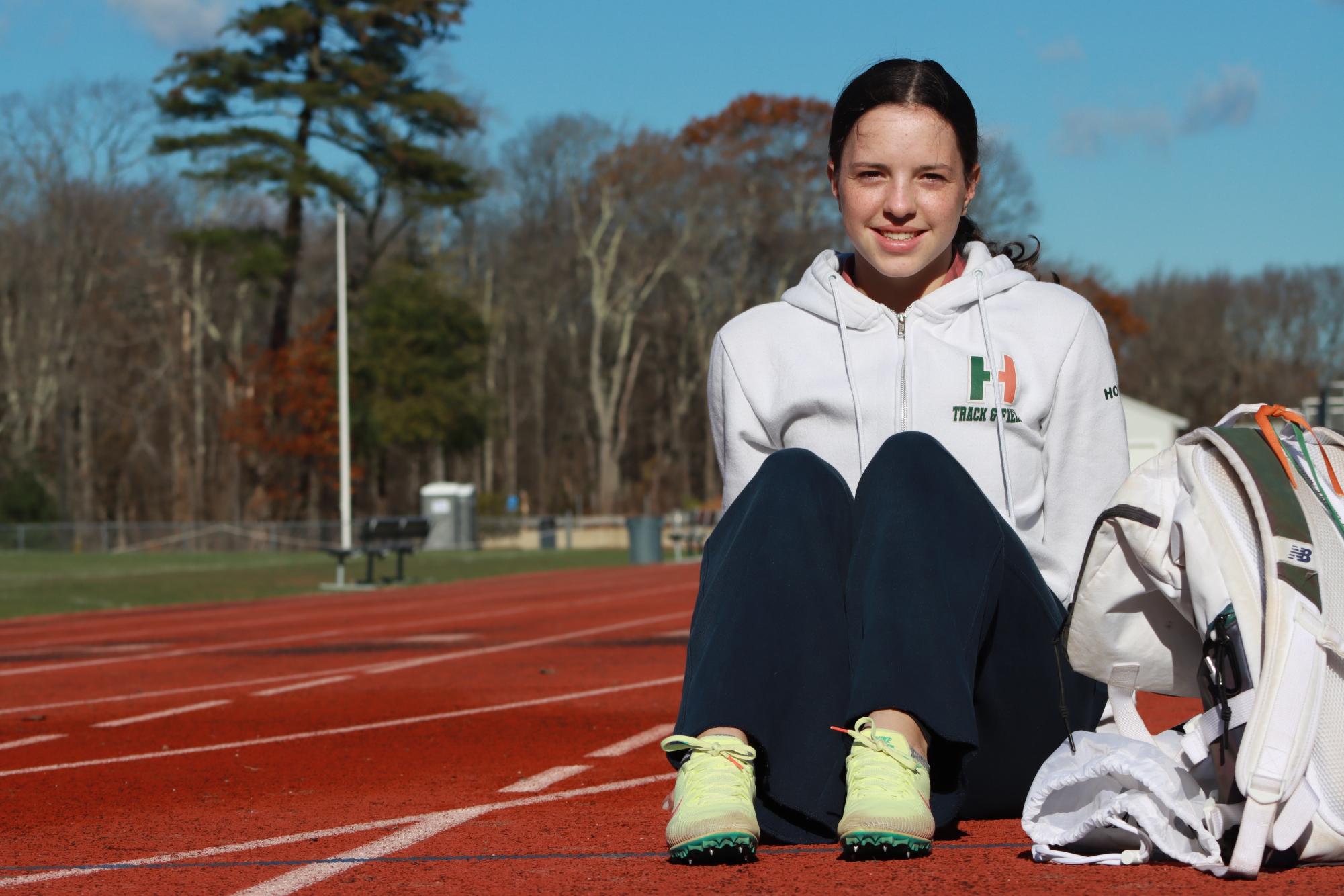
She’s a captain now. There’s no armband, but she earned the title. Prescott believes if the team’s younger athletes follow in her footsteps and emulate her desire for self-improvement and humility, Hopkinton will be a much better team because of it. Cann thinks Hopkins will be a great example to the younger athletes. She hopes that given the title of captain, Hopkins will feel more comfortable taking on the leadership role in the team she was already beginning to embody.
O’Connor attests people will follow the natural-born leader and Hopkins has the potential to drive the team toward something special. Hopkins herself is purely excited. She loves track and field. She feels privileged to spend more time in her spikes.
Exhaling, Hopkins bends down to tighten her sneakers. After a few quick hops, she heads out onto the track. She’s ready to warm up, to prepare, to compete. To lead.

